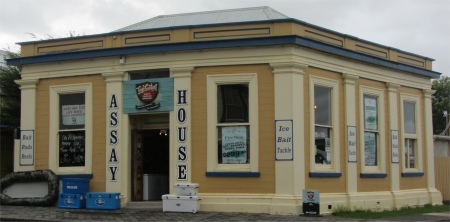 1874 Old Assay House |
I had forgotten to buy some milk the previous day, so cereal was out of the question this morning. I had to contend with cheating and buying breakfast in town. "How's it going this morning?" asked the young guy at the cafe counter with a large cheery smile glued to his face. "Just fine," I replied. "If you can organise some sunshine for breakfast, it would be even better," I teased. "You know New Zealand, four seasons in one day," he said and laughed out loud. With his banter and happy-go-lucky outlook he managed to persuade me to have scrambled eggs on garlic bread with a hot pepper sauce. It was delicious.
I now had some time to explore around the small town. The first European contact with the area originally named Waiou by local Maori, was in 1795 when the ship Fancy arrived to cut kauri spars for the Navy. The Coromandel did not arrive until 1820.
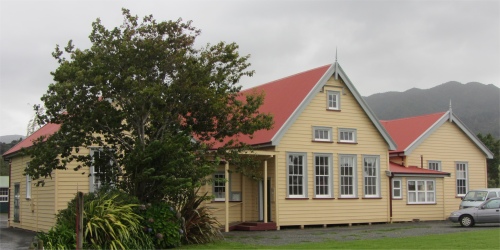 1877 Hauraki House - Former Primary School |
During the 1870s as the town "boomed", the Courthouse, School, National Bank, Presbyterian Church and many residences were built, and more than 20 of these buildings still survive. On Christmas Eve 1895, a fire that started in the Star and Garter Hotel destroyed much of the business district. A year later the Coromandel Volunteer Fire Brigade was established. World War I saw the end of the mining boom and the area developed a strong agricultural industry.
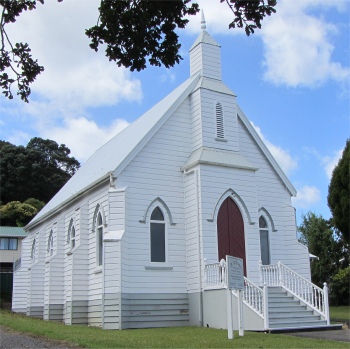 1873 St Andrews Presbyterian Church |
Most of the cafes and shops in the town are centred on Kapanga Road which runs directly inland from the port. I took a walk up the street, past the Old Assay House, a classical styled Victorian bank building erected in 1874 as the National Bank. It was described at the time as a neat, one storey building with a banking room and gold department divided by a door from the ledger keeper's sitting room and bedroom, with a detached kitchen, servant's bedroom and storeroom. A separate melting house for gold contained two furnaces. Since then, the building has been used as a solicitor's office, a tearoom, and nowadays it sells fishing tackle and bait. As I walked by, two elderly women were giggling at a sign in one of the windows. "I know what you're thinking," I said to them with a wink, and they burst into fits of laughter. The sign said "Old fishermen never die, their rods just go limp".
Further up the road was Hauraki House. This former primary school was built in 1877 in response to the increasing population of the "lower town" and to the 1877 Education Act allowing free education for all between the ages of 7 and 14. It closed as a school in 1977 after 100 year's service and has since been used as a cultural centre.
The site for St Andrews Presbyterian Church was bought in December 1872 for �50, and building started in January 1873. It is a fine example of early church architecture in New Zealand, featuring an imposing tiered tower at the front and false buttresses on each side.
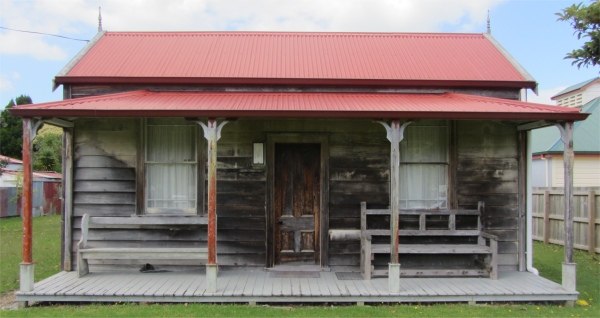 1870s Old Miner's Cottage |
At the top end of Kapanga Road stood the Coromandel Mining and Historic Museum, the original School of Mines. Despite the sign outside saying "Open", it was shut, but fortunately I noticed a note pinned to the door, "If you want to visit the museum, pop across the road to number 900, and we will come and open it for you". Opposite the museum was number 840, so my lightning speed mental arithmetic told me number 900 must be a fair way up the road. I did a double take, it was two doors up. I knocked on the door, a chap answered, and I was told to pop back to the museum and someone would be over to open it in a minute. In less than a minute a woman had crossed the road to let me in. "Excuse me, a rather odd question this, but what happened to the 30 or so houses between numbers 840 and 900?" I asked, pointing to the house numbers. "Oh, we have two different systems here, depending upon whether you adopt the postal system or the fire station system. I have never understood it. I think these numbers are a measure of the distance from the police station," she replied. "I see," I said in my most convincing glazed expression. I still have a lot to learn. The museum gave a fascinating glimpse of pioneering life in those gold-rush days, and I had a lovely chat with the old dear who took over manning the desk as more visitors appeared.
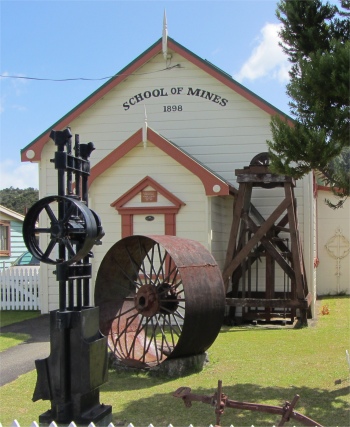 1898 School of Mines |
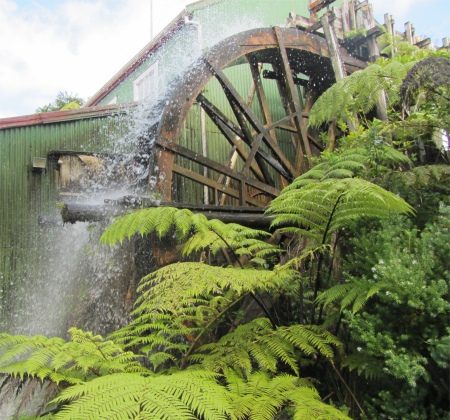 Stamper Battery Water Wheel in Action |
A tour was run around the battery building by a chap called Ashley. However, he had broken his arm in a couple of places, so his wife stood in for him. A lady of Polish origin, she provided an extremely informative account of the history of the Coromandel Peninsula gold mining, and went through the process of ore crushing using the battery stamper, how mercury was used to extract the gold, and how the gold was finally separated from the amalgam. The building we stood in contained all the equipment used in the overall process, and the battery actually crushed ore and did go through all the process of extracting the gold on site. We saw examples of the final bullion output poured from the crucibles. This was the only example I had seen in New Zealand of what could be described as a fully functional stamper and gold processing plant, and I came out fully understanding how it all operated. The lady also outlined the functioning of its cyanide counterpart. I was most impressed. To cap it all, she even climbed up high to open a sluice gate that allowed a gravity fed head of water to actually spin around the waterwheel outside, which in turn set the innards of the building into motion. The lady's account was very entertaining, and by all accounts her husband spends hours regaling visitors with technicalities and stories. Well worth the visit.

